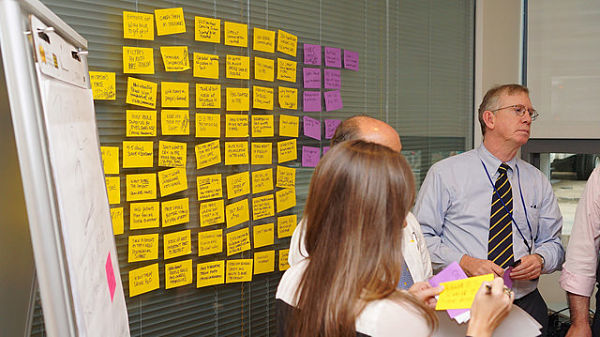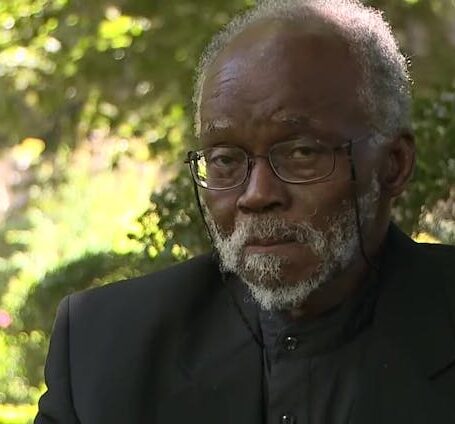 Impact
Impact Mobilizing Social Science to Fight Ebola

The battle against Ebola requires more than bunny suits:brainstorming at a Fighting Ebola Workshop with the White House Office of Science and Technology Policy at Center for Total Health. (Photo: Ted Eytan/Flickr)
The National Science Foundation is looking to the social sciences as the United States continues to evolve its response to Ebola. The director of the NSF, France A. Córdova, last week issued a ‘dear colleague’ letter soliciting shovel-ready research “to better understand how to model and understand the spread of Ebola, educate about prophylactic behaviors, and encourage the development of products, processes, and learning that can address this global challenge.”
In the short letter, Córdova highlighted the Rapid Response Research (RAPID) funding mechanism for this urgent research. As its name suggests, RAPID allows the federal and scientific bureaucracy to recognize and react closer to real time, as guidance on the NSF website details:
The RAPID funding mechanism is used for proposals having a severe urgency with regard to availability of, or access to data, facilities or specialized equipment, including quick-response research on natural or anthropogenic disasters and similar unanticipated events. PI(s) must contact the NSF program officer(s) whose expertise is most germane to the proposal topic before submitting a RAPID proposal. … The Project Description is expected to be brief (two to five pages) and include clear statements as to why the proposed research is of an urgent nature and why a RAPID award would be the most appropriate mechanism for supporting the proposed work.
Projects can receive up to $200,000 in NSF funding.
Most of the attention that connects Ebola and research focuses on the search for a vaccine – something the World Health Organization has suggested hopefully could be extant by the first of the year – or a successful therapeutic drug. But given the specifics both of the viral disease’s transmission and the concerns of (even lightly) affected populations, social science also has been front and center in efforts to curb the killer.
This more-than-medicine requirement isn’t a new-found realization (although recognizing the benefits of social, behavioral and economic science might be unwelcome in some quarters). As Felissa R. Lashley wrote for Biological Research For Nursing in 2003, in an article where she mulled if “social customs, cultural practices, and human behavior” might be an “overarching” issue in dealing with disease:
Effectively addressing threats from emerging infectious diseases requires cooperation and communication among a large variety of professionals, including those with expertise in animal disease, ecology, behavioral science, epidemiology, basic science, public health, medicine, and nursing. We must meet this new challenge.
Even before the current outbreak in West Africa, now seven months old, social scientists had conducted a number of studies looking responses to Ebola, whether by populations directly confronting the disease or cultures buffeted by having it in their midst. Some of the resulting journal articles were both prescient and now in need of sequels, and range from the theoretical to the very practical.
One of the most recent full texts on emerging infectious diseases came out last year, with Social Science Space blogger Robert Dingwall alongside Lily M. Hoffman and Karen Staniland as editors. Pandemics and Emerging Infectious Diseases: The Sociological Agenda examines a number of issues which have arisen during the current crisis, including the politics of closing borders, how New York City specifically has reacted to past infections, and an examination of how the media affects fears of becoming infected.*
A dozen years ago in Tropical Doctor, 18 authors led by Medard Bitekyerezo described “The Outbreak and Control of Ebola Viral Haemorrhagic Fever in a Ugandan Medical School.” Four patients were diagnosed with Ebola; all died. No medical staff caught the disease. While aimed at a medical audience, descriptions of contact experience (“A local radio station even advised its listeners to ‘run away’ from all staff members”), the overlooked psychological and spiritual needs of the affected, and the miasma of fear that accompanies reports of the disease all pointed to the interdisciplinary requirements that battling the disease require.
Two Australian-based academics, David Santandreu Calongea and Danilla Grandob, examined teaching how to deal with outbreaks in the classroom two years ago in Health Education Journal. They described developing “a totally online reality-based course that engages students and enables the development of enhanced teamwork and report-writing skills” that would be applicable in dealing with a real outbreak (their scenario) or in other potential disasters.
The media’s role have also been studied, albeit more descriptively than prescriptively. A 2011 article in Science Communication suggests the early observations:, “Efficacy Information in Media Coverage of Infectious Disease Risks: An Ill Predicament?
In 2011, Helene Joffe asked the readers of Public Understanding of Science, “Public apprehension of emerging infectious diseases: are changes afoot?” While that paper feared an incipient o emerging and re-emerging infectious diseases (EID) fatigue, it also spotlights a dynamic occurring in the United States, where trust in public health infrastructure has taken its knocks. “The key shift relates to who is ‘othered.’ Thus rather than blame and stigma being directed ‘downward’ at traditionally marginalised, derogated groups, it is being levelled ‘upwards’ at powerful agents such as governments and international agencies such as the WHO.” While this shift may not be apparent to Liberians residing in the U.S. who are being asked not to come to work, it does reflect the difficulty that officials in the U.S. have had in commanding a bully pulpit in this crisis.
In an accompanying commentary on Joffe’s and another paper in that issue, Peter Washer observed the ways that perceptions of risk mutate –certainly driven by the need for journalism’s ‘day-two story’ — even more rapidly than the underlying virus:
‘Risk’ in this Beckian sense is not synonymous with ‘catastrophe,’ but rather with the anticipation of catastrophe. Once a risk becomes real – for example, when the predicted next influenza pandemic arrived in 2009 – it ceases to be a risk, because the risk has moved elsewhere: to the possibility that the virus might mutate, to the alleged risks of vaccination or non-vaccination, to the effects of the pandemic on everyday life and the economy, to the risks posed to travel, trade and global markets.
* This paragraph was added after this article posted.
































































































Surprised to see no mention of the most relevant recent source: R. Dingwall, L.M. Hoffman, K. Staniland (eds) Pandemics and Emerging Infectious Diseases: The Sociological Agenda, Wiley-Blackwell, Oxford, 2013.
Does nobody do proper literature searches any more?